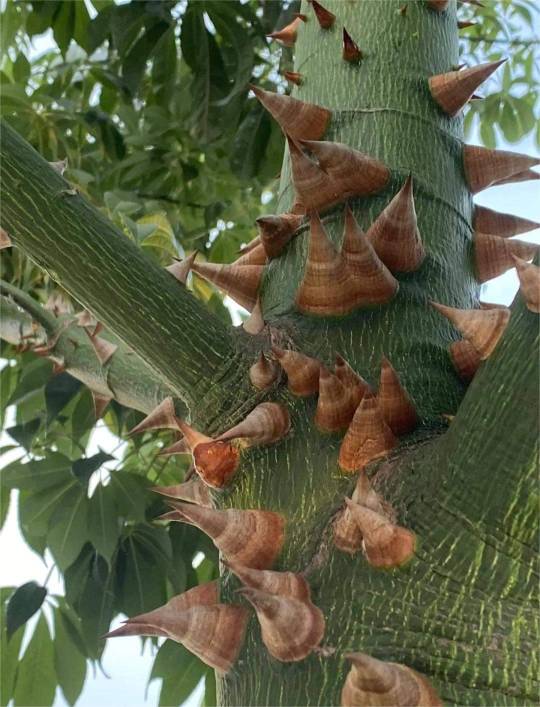#ceiba pentandra
Explore tagged Tumblr posts
Text
"Sunlight dapples the once-denuded forest floor as saplings spread their branches and leaves overhead, slowly forming a lush canopy.
Beside each young tree, a sign notes its species. Lupuna, says one, the colloquial Peruvian term, and below that its scientific name, Ceiba pentandra — in other words, a kapok tree, known for its cotton-like fibers. Huito, says another sign, or Geinpa americana, which produces edible gray berries.
Each sapling is distinct, a reflection of the Amazon's stunning biodiversity, with so many different species that you might go acres without finding a repeat.
Yet this young forest did not spring up naturally. It has been carefully recreated by humans in an area that was, until just three years ago, a heavily contaminated moonscape.
This land was stripped of its dense vegetation by miners scouring the subsoil for tiny specks of gold, using mercury to separate the gold from the sediment. Many thought that a healthy forest would never thrive in impoverished, mercury-laden topsoil and that the piles of sandy tailings, the residue from the gold mining effort, and the pools of wastewater were irremediable...
"It feels good to see the forest grow back," says Pedro Ynfantes, 66, the miner whose legal mining concession of 1,110 acres includes this 10-acre patch of land where this young forest is located. "We don't want to deforest. When we had the opportunity to let the forest grow back, we took it. It's much better this way."
The opportunity he refers to came via U.S. nonprofit Pure Earth, which works with communities across the Global Southto remediate environmental problems left behind by mining, much of it illegal. Their biggest targets are mercury and lead contamination...
Security forces have launched anti-mining operations down the years, even blowing up the miners' equipment deep in the jungle. But most local politicians, including Madre de Dios' members of Peru's national congress, broadly support the miners, who are a powerful constituency in the relatively sparsely populated jungle region.
Restoring the forest
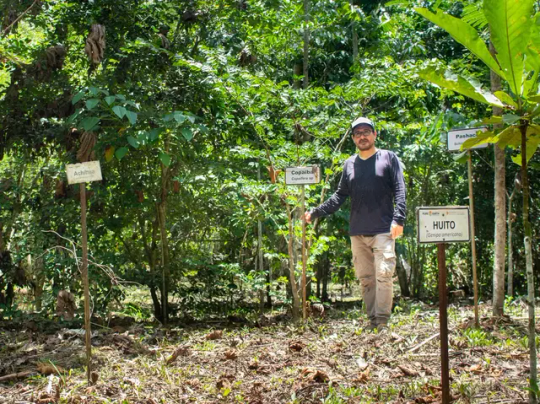
Pictured: France Cabanillas works for the nonprofit group Pure Earth, which is spearheading an effort to plant saplings in areas of the Peruvian Amazon that were devastated by illegal gold mining.
Now there's an effort to address the damage. Initially working with the region's legal miners, most of whom were here before the 2009 gold rush kicked off, the nonprofit group Pure Earth is using this patch of Ynfantes' land as a pilot project to show how the rainforest can be regenerated after the last traces of gold have been plucked from the soil.
It took a sustained outreach effort. Many miners are wary of or even downright hostile to foreign NGOs, which have repeatedly called for gold mining to be banned or severely curbed in the Peruvian Amazon — steps they say would cost them their livelihood.
"I am feeling optimistic," says France Cabanillas, Pure Earth's local coordinator, who has been appealing to the frustration of many miners at the heavy toll they have taken on the jungle and their desire to minimize their environmental footprint for the next generation.
"We still have a lot to do but this pilot is going well. Down the years, the miners have been getting a lot of stick but not much carrot when it comes to their environmental impacts," says Cabanillas. "We are offering them a carrot, allowing them to remediate their own impacts. Many of the miners do not want to be destroying the rainforest."
Before the miners plant the carefully-selected mix of tree species, they had to prepare the earth. Most of the topsoil had been washed away by the miners' heavy use of hoses.
That preparation involved adding biochar (burnt organic material) and even molasses, which contain fixed carbon and minerals, along with various other nutrients. The miners also had to dig tiny moats around the saplings to prevent all of this new planting from being washed away. Now, after three years, the forest is visibly coming back.
The rejuvenated rainforest also mitigates the impact of the mercury used by many of the illegal miners.
Research done by Pure Earth shows that the barren, sandy soil emits mercury. But in a rainforest, the ecosystem actually absorbs some of the metal, boosting public health."
-via NPR, April 2, 2024
#mining#illegal miners#gold#gold mining#peru#rainforest#ecosystem#mercury#environment#pollution#remediation#reforestation#good news#hope
386 notes
·
View notes
Text
Tiputini Tower
Elliptical granulated floor made of glucose in its various consistencies; from this height, I realized how lost I would feel. Violent yet loving screeches emanate from different teguments: keratinous, soft, discontinuous, and desired. The upward tendency of the warm, particular, and massive air columns that seize nostrils with living matter move the monstrous tree, from which the only object in sight hangs tight, the 50-meter-tall metallic mastodon. The platform has a green coloration, not a mimicking but burlesque green. Conspicuous and deep earth belonging, processed green. A green that could only be obtained after erasing a forest like this. Besides the ladder, I'm wearing the clothes that shield me from the sweat-seeking bees living in that Ceiba pentandra
Now it’s 6 p.m., and at least up here, the air has lost its weight. Different bodies take over the soundscape. Large groups of fruit-eating birds head back to their shelter tree, squawking in unison. Colorful, angular, and larger insects come out of their crevices to consume what was left behind for them. The chain-churning, sand-shaking sound of cicadids and orthopterans gives the rhythm of the entering night, dominated by humid and scaly skins. The parrots and toucans will rest until tomorrow.
2 notes
·
View notes
Text
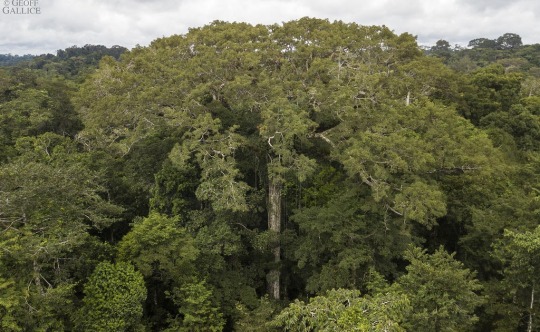
Дерево Сейба (Ceiba pentandra) http://dlvr.it/Swfdg3
22 notes
·
View notes
Text
Sanctuary of the Unseen Forest is a large-scale video installation that creates a moment of awe, felt, when we embrace the presence of a majestic being, a giant Ceiba pentandra from the Colombian Amazon. The artwork becomes a sanctuary, a place to reflect and contemplate our place within the wider systems of nature. Plants are alive, yet they do not present us with the same impression of life that animals do. Are we, as the victims of plant blindness, simply unable to notice their liveliness, or are they so different from us that we have to invent new ways of seeing and apprehending them?
Radical Botany – N. Meeker, A. Szabari
2 notes
·
View notes
Text
27.-29.10.2023
Worum's geht: Die ersten Nächte auf meinem 6-Tages-Trip im Dschungel ("Softcore Amazonas"), Poledancers & bush negros

Habe die erste soweit geruhsame Nacht am Rande des Dschungels hinter mir, nachdem wir gestern von Atjonie fünf Stunden den Suriname River stromaufwärts gefahren sind, und zwar fast ohne Pause (eine Ausnahme bei der wir wegen des Wasserstands aussteigen und laufen mussten). Mir tat, gelinde gesagt, der Arsch weh. Die Sitzbank in dem dachlosen Taxiboot besteht aus einer einfachen Holzplanke und der Motor brummt unangenehm durch den ganzen Bauch. Wir sind in einem schönen Lodge in dem schwarzen Dorf Goejaba untergebracht; der Flair ist hipp aber einfach, Strom zum Handyladen sporadisch verfügbar und die einzigen Gäste sind junge modisch tätowierte Damen in bunten Strandtüchern, die mit ihren Tourguides kichernd baden gehen. Später werde ich mich bei dieser Erinnerung etwas angeekelt schütteln, denn da schwamm noch ordentlich viel Müll im Fluss; kein Vergleich zu dem trinkbaren Wasser am Sintiadam.
Meine Lodge-Nachbarn in Goejaba sind drei Surinamesen aus Paramaribo, die für das Wochenende ausspannen. Ich komme kurz mit ihnen ins Gespräch. Kevin, einer der drei, ist hocherfreut, als ich ihm von meinem IT-Job erzähle. Er selbst habe gerade seinen Abschluss in Informatik gemacht. Ich: "Really? I would not have guessed!" Warum ich das sage? Weil Kevin nicht dem Stereotypen des Informatikers entspricht. Er erinnert mich an die Theaterstudenten aus meiner Unizeit, allein von der körperbewussten Art, wie er sich bewegt, und von den kunstvollen Tattoos auf der nackten Brust. Kevin zuckt mit den Schultern, er nimmt mir meinen Kommentar nicht übel, da habe ich nicht Unrecht, meint er. Seine Reisebegleiterin (und Trainerin), die sich über das Geländer der Terrasse beugt, sagt, dass sie eine Truppe von Poledancers seien. Es dauert nicht lang, da zeigen sie mir verblüffende Videos ihrer Choreografien. Die Dame hat ihre eigene Tanzschule aufgemacht, obwohl der Stangentanz (noch) keinen guten Ruf in ihrem Heimatland genießt. Siehe Insta-Video unten (eventuell nur sichtbar mit Instagram-Konto).
instagram
Unsere Reisegruppe ist alles andere als sexy. Sie besteht aus mir, zwei jungen niederländischen Brüdern, die die meiste Zeit über ihre eigenen Füße stolpern, weil sie den Blick vom Handy nicht heben können, und Sensi, unserem gemütlichen und logistisch leider völlig untalentierten Buschmann und Tourguide. Morgen stoßen dann noch die Bootsmänner Hesti und Freddy hinzu. Am Ende der Reise werde ich erfahren, dass Sensi und ich wohl die einzigen waren, die so etwas wie Seife zum Waschen benutzt haben. Sensi fühlt sich im Regenwald merklich wohler als in der Logistik. Ich erlebe ihn in der Zivilisation als hektischen Mann, der bei der An- und Abfahrt im Hafen von Atjonie umkehren muss, weil er etwas vergessen hat einzupacken, oder der entgegen der persönlichen Planung plötzlich kein Eis für die Kühlbox (die 6 Tage lang halten muss!) auftreiben kann und auf der Autofahrt zum Hafen dreimal anhält, schließlich bei Familie/Freunden. Sogar das eigene Mittagessen vergisst er, also zeige ich Erbarmen und teile meins mit ihm. Ich erzähle dies mit aller Zuneigung und dem Respekt, der ihm für seine Leidenschaft gebührt, denn er ist ein ganz hervorragender und menschlicher Führer, der für seine KundInnen auch bereitwillig die Extrameile geht. Die kleinen Diskrepanzen haben das Dschungelerlebnis in keiner Weise geschmälert, sondern mir eher gezeigt, unter welcher Arbeitslast ein Freelancer wie er steht. Ab dem dritten Tag, als wir das letzte Dorf hinter uns gelassen haben und nur noch Regenwald vor uns liegt, fällt die letzte Hektik von Sensi ab und er wird der stille Meister mit der Machete.
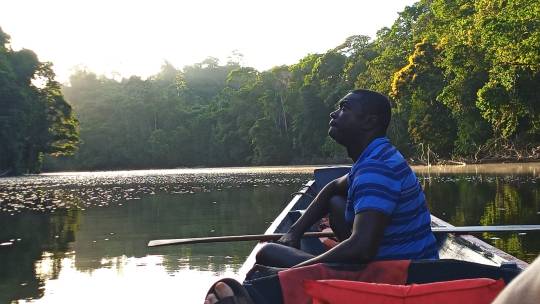
Pic: Sensei Sensi sensing the wild.


Pic: Das Periodenhaus für die menstruierende Frau. In dieser Zeit darf sie nicht für die Gemeinde kochen. Fast wie Urlaub. Pic 2: Der Ceiba pentandra - ein heiliger Baum, unter dem sich die Hütten der Saramaccaner ducken.
Aber eins nach dem andern. Auch die zweite Nacht verbringen wir noch unter den Saramaccanern (einer der großen Afro-Stämme Surinams) und genießen den "Luxus" einfacher Holzhütten mit der unzuverlässigen Strom- und Wasserversorgung doch dafür mit der köstlichen surinamesischen Küche aus Fisch, Kassava und verschiedenen Soßen und Suppen. Aber keine Sorge, brummt Sensi und ein Grinsen stiehlt sich langsam auf seine Lippen, das werde sich am dritten Tag ändern. "Then you will have to work, guys. On the third day we will have left the last village behind. After that we are in the wild." Wenn ich nach diesen sechs Tagen feststelle, dass mich der Dschungel nicht in die Knie gezwungen hat, könne ich darüber nachdenken, auf eine seiner mehrwöchigen Expeditionen in unerschlossenes Terrain mitzugehen. Die Sintiadam-Tour ist ein Amazonas-Training in ultrasoft. Nicht ganz so weichgespült wie die Resort-Touristen, sagt er ganz barmherzig. Doch im Vergleich zu einer Expedition noch Pipifax. Später, als wir im Dschungel am Lagerfeuer, das in dieser Hitze niemals richtig ausgeht, sitzen, wird er uns von den deutschen Bundeswehrlern erzählen, die bei ihm Survival-Trips in entlegene Gebiete machen, oder von einem der größten Geflügelfleischproduzenten Deutschlands, mit dem er fast jährlich in den Amazonas verschwindet, zuletzt zum über 100 Jahre alten Grab des niederländischen Kartografen Johan Eilerts de Haan.
Sensi ist selbst Saramaccaner und hat in fast jedem Dorf dieser Ecke Verwandte. Am zweiten Abend nächtigen wir in Kosindo/Kajana, in dem gerade der Tod eines Gemeindemitglieds betrauert wird, und zwar ganz nach irischer Art: mit Musik und Alkohol. Auch eine zu Ehren des Toten bemalte Fahne wird durch das Dorf getragen und es bildet sich eine lange, jubelnde Schlange, die durch die unbefestigten Straßen zieht. Wir sollen, so Sensi, es lieber unterlassen Fotos von den bunt bekleideten Einwohnern zu machen; Auf der anderen Seite halten grölende Halbstarke uns ihr Smartphone ins Gesicht und filmen uns wie die Affen im Zoo. Nun ja, unser Tourguide besucht an dem Abend noch seine Großmutter im Nachbardorf. Ich frage ihn, ob er Geschwister habe. Er gibt eine lange Antwort. Unterm Strich: Er hat viele Halbgeschwister. Aber die "bush negros", wie er sich selbst bezeichnet, leben selten monogam.

2 notes
·
View notes
Photo

These ceiba trees (Ceiba pentandra). called the kapok or silk-cotton tree in English, were seen on the eastern slope of Cerro Jaboncillo near Portoviejo, Ecuador. In South America the tree plays a role in pre-Hispanic mythologies.
2 notes
·
View notes
Text
El árbol que más amo. Mi Ceiba Pentandra
El Susurro de la Ceiba
Justo afuera del ventanal, donde la brisa de la tarde juega con las cortinas, se alza la ceiba pentandra. Su tronco robusto, marcado por el tiempo, guarda historias antiguas. Sus ramas se extienden como brazos abiertos al cielo, y en ellas descansan aves de todos los colores, mensajeras del viento y la selva.
Para quienes pasan sin mirar, es solo un árbol. Pero para quienes saben escuchar, la ceiba susurra secretos de la tierra y del cosmos.
Una noche, cuando la luna llena derramaba su luz plateada sobre sus raíces, la ceiba despertó en sueños a quien dormía cerca de su sombra. Con una voz profunda, como el eco del tiempo, susurró:
—Soy el puente entre el cielo, la tierra y el inframundo. Mi raíz toca el corazón de la madre tierra, mi tronco sostiene los pasos de quienes habitan el mundo, y mi copa besa las estrellas donde moran los dioses antiguos.
El soñador, envuelto en la calidez de aquel mensaje, vio en su mente un río de jaguares dorados, mariposas luminosas y ancianos sabios que caminaban entre los mundos. Comprendió, sin palabras, que la ceiba es guardiana del equilibrio, testigo del vuelo de los pájaros y del susurro del viento.
A la mañana siguiente, al despertar, una pluma azul descansaba en el alféizar de la ventana. Un regalo del ave que la noche anterior había escuchado también el susurro de la ceiba.
Desde entonces, cada vez que el viento mueve sus hojas, quien sabe escuchar comprende que la sabiduría de la ceiba sigue viva, protegiendo, guiando y contando historias que solo los corazones atentos pueden entender.
Adelina🍀


0 notes
Text
Kapok Fiber

Introduction
Kapuk, also known as a caster, is a natural fiber derived from the seeds of the Kapok Tree (Ceiba Pentandra). Kapok tree seeds have light properties. Kapok can be applied in various industries, including textiles, and furniture materials. When manufacturing demand increases, the role of Kapuk distributor also experienced a significant increase.
The importance of the Kapuk Distributor
Kapuk distributors play an important role in the supply chain by facilitating Kapok -based production. Here are some of the main functions they perform: Sources and procurement: As a distributor directly cooperation with farmers and Kapuk producers to get high quality raw materials. Not only ensures that the supply of the cottonwives is stable but also supports the local economy. Quality Control: One of the main responsibilities as a Kapuk distributor is to maintain product quality. As a distributor of Kapuk conduct inspection and tests to ensure that the quality of the cotton must meet the quality of industry standards. Market Expansion: Distributors help introduce Kapuk products, expand the reach of producers. By utilizing the network and marketing expertise, distributors can show the benefits and uses of Kapuk products to prospective customers. Knowledge: Many consumers are still unaware of the advantages of using kapok rather than synthetic fibers. Kapuk distributors often provide educational information to promote the benefits of Kapuk products, such as sustainable biodegradability.
Kapuk Product Market
Global demand for sustainable and environmentally friendly materials continues to grow, making the Kapok of the in demand. Industries such as manufacturing, furniture, and others. In textiles, for example, cotton fiber is used to make soft fabrics and biodegradable, so that it is attractive to consumers who prioritize environmentally friendly products. Kapok -based mattresses are in great demand natural isolation and hypoallergenic quality.
Conclusion
Kapuk Distributors play a role in the success of the Kapuk industry, the distributor acts as a bridge between producers and consumers. By promoting quality products, distributors not only contribute to environmental preservation but also help develop the local economy. Because the environmentally friendly product market continues to increase, Kapuk distributors will also continue to increase, so that the sustainability of Kapok sports products will continue.
1 note
·
View note
Text
Hail Caesar, Those About to be Dispossessed Salute You!
By Tade Ipadeola
When colonists first arrived in Africa, they convinced themselves that Africans had no real sense or conception of ownership. Also, they came from their home regions with a notion that possession was 99% of ownership, anyhow, and began to act on these profound errors in various ways. They raided, maimed and killed to name landmarks and even countries after themselves – Lagos, Victoria Falls, Lavington Hills, Rhodesia, Victoria Island, Escravos, and Johannesburg etc. When they found an African name cute enough, they thought it wiser not to change it because, well, gifting Kilimanjaro to your favourite nephew in Germany was a cooler thing to do than renaming the mountain. Everyone knows that it would be a tough assignment to come up with an English name surpassing Kilimanjaro. You see, a word as intriguing as, say, “chimpanzee” has more primal and exotic ring to it than any variorum of the word “ape”.
Governor Makinde of Oyo State of Nigeria has been acting very much like the colonizers over those who are supposed to be his own people. Whereas one can make up a case for the Arab or the European occupier – they laboured under baffling ignorance regarding the humanity of dark skinned Africans, for the most part, but no such excuse(s) can be made for a Seyi Makinde whose mantra to power is “Omi Tuntun.” He, of all people, should know better than to join Caesar's circus. He should act with a consciousness of his people’s history and their common heritage. So far, and with alarming intensity since his second term in office began, he has done the precise opposite of what a thoughtful civilian governor should do, with devastating consequences for the environment and society at large.
Like a dark and malevolent rumour, word began to spread in Oyo State that the Trans Amusement Park would be sold to private estate developers, along with the Agodi Ogunpa Forest Reserve and Gardens. The rumour was received with some consternation by citizens. Then followed the implementation of a 1 kilometer setback (500 meters on either roadside) for a circular ring road for Ibadan, the State Capital. The interesting thing was that even under the Federal Highway Act, the setback on either side of a Federal Trunk A road is precisely 47.5 meters. Up until the present, the people of Oyo State do not have a replacement for the Trans Amusement Park, thoughtfully provided by the Bola Ige administration, now taken away from them by Caesar Omi Tuntun and his cronies.
Out of the blues, Caesar went public with the grandiose idea for a 3,149 hectare Ilu Tuntun Business District. This Caesar, whose public rating on assumption of office as governor ranked as high as that of any popular governor of Oyo State, began to sink rapidly in the public estimation of Ọ̀yọ́ citizens, with the State Secretariat at Agodi hosting mammoth protests by citizens whose ancestral land holdings were being systematically stripped by vested commercial interests citing support from the governor’s office.
Take the Baywood Estate, so called, which is planned to occupy the carefully conceived and executed 70 acres of 70-year-old Agodi Ogunpa Forest Reserve and gene bank. All 70 acres have been stripped utterly bare, with the topsoil gone and the subsoil exposed today. Over 25 rare species of trees from as far away as Australia, India, Burma and Sri Lanka are now gone, perhaps forever. Eucalyptus torelliana, Terminalia superba, Terminalia ivorensis, Terminalia catapa, Nauclea diderichii, Ficus exaperata, Tectona grandis, Gmelina arborea, Khaya grandifolia, Ceiba pentandra, Milicia excels, Anthocaphalus cadamba, Alstonia bonnie, Albizzia labbeck, Triplichyton selerexylon, Bombax buonopozense, Cedrela odorata, Morus alba, Funtumia elastica, Albizia zygia, Antiarii toxicaria, Celtis zenkeri, Cola gigantea, Cordia millenii and Mansonia altissima among others, all gone because Baywood Infrastructure Limited and Caesar thought it wiser to wipe out this enormously rich bequest of the Western Region Government to future citizens of the region. The elders thought that by investing huge resources in this forest reserve and making a Gazette for its preservation, there is thereby a legal guarantee that it would remain a gift in perpetuity to mankind as well as reliable protection for the Ogunpa water basin.
Caesar and his two collaborator-directors of the Baywood Infrastructure Limited, one Abiodun Adebayo Otunola and another Favour Nene Otunola ended that grand vision of the forefathers without as much as an inventory of what they took from the commonwealth or where they took it or how much for the public to know. Although conscientious citizens brought the legal status of the forest reserve to Caesar’s notice, he and his accomplices disregarded the notification and today the bulldozers are in Agodi, making the open wound on the face of Oyo State wider, siting up Ogunpa and altering the hydrostatic balance of the basin.
By September of 2024, downstream from the Agodi Ogunpa Forest reserve, just months after Baywood began its thoroughgoing destruction of Agodi Ogunpa Forests, floods killed 2 persons and the National Emergency Management Agency declared 2 persons more missing. These horrendous developments just downstream from the violated Agodi Ogunpa basin, were avoidable tragedies. The world is hereby put on notice not to participate in this ongoing crime against the citizens of Oyo State and their environment by way of any ‘investments’. Caesar’s cynicism in setting up a so-called Flood Management Agency also reeks of Orwellian cheek https://von.gov.ng/oyo-state-set-to-establish-flood-management-agency/ because there is no one more active in mismanaging the flood situation than Caesar himself.
But by far the most insidious development yet is the so-called Ilu Tuntun Business District. The Punch Newspapers and other media sources report that Caesar and his foot soldiers have come up with a design to do what the Yoruba describe as hosting Àwé to a treat with Àwé’s funds. Fífi owó Àwé ṣ’Àwe lálejò - https://punchng.com/oyo-to-establish-business-district-in-ibadan/
In this grand plan, Caesar takes some 3,149 hectares from the people and resettles the dispossessed on 598.613 hectares out of the main snatch. To put a veneer of legitimacy on this heist, Caesar and his minions rustled up a ‘stakeholder meeting’ with the people who are to be affected by the model business district which is the largest ever in the world. At present, Midtown Manhattan, with some 288 hectares of land is the largest business district in the whole wide world. The stakeholder meeting is a study in how internal colonization works. On the face of it, the 3,149 hectares over which Caesar summoned the ‘stakeholders’ has the poor and the powerful in its dragnet. There was no meeting, only a simulacrum of one. The poor were present but the powerful Railway Corporation of Nigeria, whose facilities and lands Caesar also ostensibly acquired, were notably absent. By Monday, the 4th of November 2024, minions from Caesar’s Agodi Secretariat had begun marking houses of the poor for demolition all over the ‘Ilu Tuntun Business District’ but not one mark was placed on any property of the Railway Corporation. It appears that even rabid dogs observe boundaries when approaching lion territory. The entire charade showcases the mind of an internal colonialist at work, the mind of Caesar bringing civilization to the brutes, or so it seems.
The Akinyele Local Government Chairman who spoke for Caesar rather than the citizens should know that ‘investors’, foreign and domestic, have been put on notice that Caesar cannot give what he does not own. In a democracy, every town, village and hamlet, every land holder has a say. Those planning to situate their businesses in a contested, ancestral space should know that people persuaded against their will remain of the same opinion still. To reiterate a trite point, Oyo State does not have funds enough to relocate the ancestors of Akinyele from the earth that holds their cherished remains. Ọ̀yọ́ is currently indebted in billions.
Africans have fought colonizers to have their own returned to rest in native soil under African skies for a reason and Caesar may just have to humble himself, get off his high horse, and respect the people and the ancestors. The ties that bind may be invisible but they are nonetheless real. It is foolish, to say the least, to think that the poor can be exploited together with their honoured dead by mercantilist tinkerers without unintended consequences.
Here we have oríkì and we have orílẹ̀. If any governor claims to be one of us and not a Caesar of a circus, that person must know what these mean. The subject of ancestral African land and the African environment and heritage will become even more central the more we negotiate modernity, industrialization, and change. The very importance of these subjects necessitates a thoughtful approach rather than whim and diktat. May God help the wolf after whom the dogs have ceased to bark.
Tade Ipadeola, lawyer, retired civil servant and nationally decorated poet, writes from Ibadan.
0 notes
Text
Cerpen: Kapok Ceiba Pentandra
Batang randu berduri tak tumbuh lagi di musim ini. Kulitnya semakin kering, pecah dan keabuan
Batang randu kering memilih tak melanjutkan hidup lagi semenjak terakhir kali ditinggal sendiri. Buahnya dipitas dan cabang rantingnya dipangkas. Geraknya tandas, penuh keraguan
Batang randu yang kokoh dan tinggi masih bernyawa. Tapi ia tak lagi tahu harus membagi ke mana hara yang dibawa. Batang kuat kokoh dan kaya, tetapi hidupnya kesepian
Batang randu memilih. Meski berat. Mengakhiri hidupnya. Menekuk akar-akar yang ia punya. Menyusul kepergian buah cabang ranting ke tempat pergiannya
0 notes
Text
Siembran 100 árboles en la Plaza Grande de Mérida
-En la jornada de este día y bajo la supervisión de personal de la Secretaría de Desarrollo Sustentable (SDS), se sembraron ejemplares de la especie maculís y ramón, que forman parte de más de un centenar que establecerán paulatinamente en este punto de la capital yucateca. -La noche de ayer martes se colocó el primer ejemplar de la especie Ceiba Pentandra de 12 metros de altura y hoy por la…
0 notes
Text
Day 24 - The Peruvian Amazon
We head to the dining room for coffee before we start our boat trip. Neither of us slept very well - not really on account of the animal noises surrounding us but because my cough is getting worse, plus the bedsheets were damp because of the humidity. Today we are going to the Macaw clay lick. We take the boat 90 mins upstream and pull up to a “beach” alongside a bunch of other boats. We sit on our stools waiting for the parrots to arrive. There are some birds flying overhead an in the trees but it’s a slow morning - Marco assures us that as long as it doesn’t rain they will come. In the meantime we learn a bit about the different macaws, parrots and parakeets we can see). After a while we go back to the boat and have some breakfast that was packed for us - a boiled egg in a brioche bun (a little strange but it fills a hole).

Not long after starting breakfast the birds start to come. We finish up and bring our stools back up the beach to watch. The birds are quite far across the river from where we are but we can see them through Marco’s telescope. He explains to us that the birds come here for two reasons 1) to get minerals from the clay and 2) to find a mate (parrots stay in couples and are monogamous).
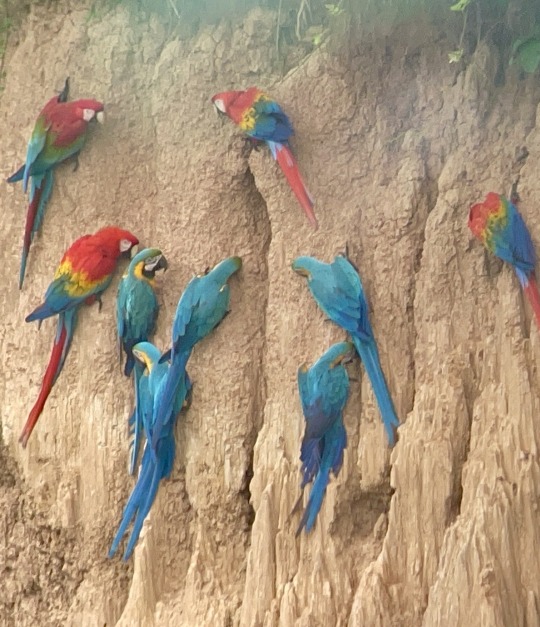
Apparently there were some other clay licks in the region bit as the clay cliffs have moved further from the riverbank vegetation has grown over them meaning that the parrots no longer visit. Marco says this is the case for Collpa Colorado and Collpa Chunchos hence today we are at Collpa Ocho Gallinas (although on Google maps it is marked as Collpa Chunchos). This is one of the last remaining so they need to keep it clear of vegetation to prevent this from happening.
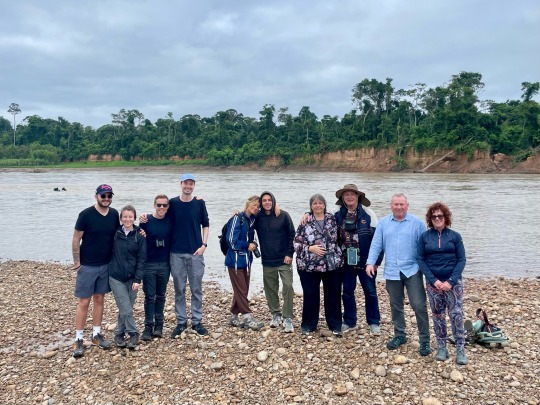
Next we jump back on the boat and go down a smaller channel to try and spot other wildlife. We find several families of Capybara (Jack was very happy about this), a caiman and lots of turtles.
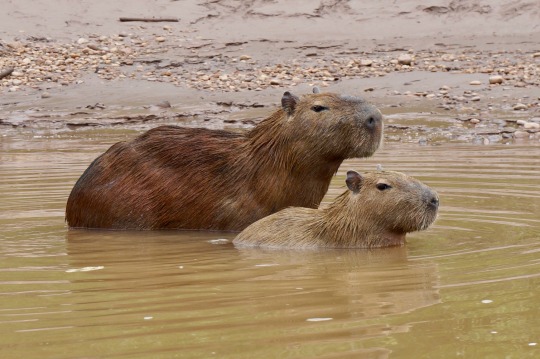

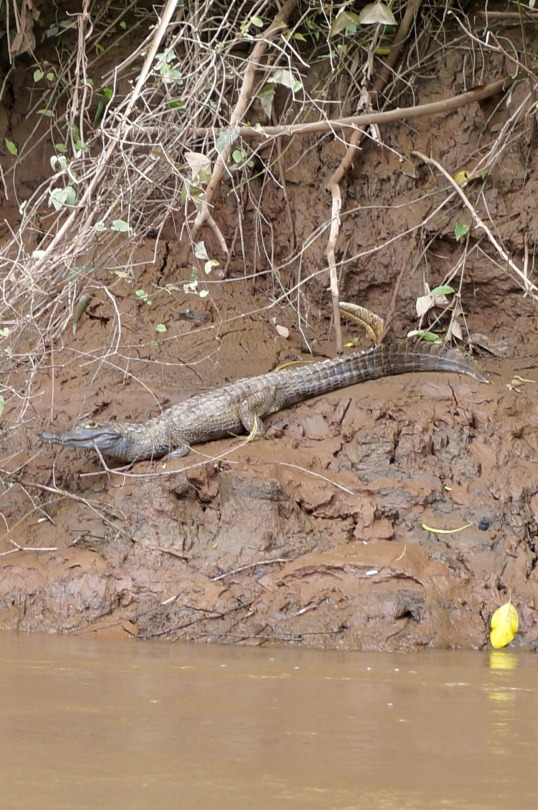
Time to take the boat back to the lodge - we need a nap. We manage to sleep better as we are so tired but I also start getting a fever - I’m wrapped up in blankets despite it being hot.
At 1pm we head into the dining room for our lunch - it’s Aji de Gallina (the dish I had in Cusco).
I’m dosed up on meds so feeling a bit better, there is just enough time to use the wifi before we go on the 3pm hike.
The hike is not very far and we are continually stopping to see stuff. Some things that we encounter are a tarantula’s nest (Marco tries to entice it out by simulating pray with a vine but it doesn’t fool for it) and learn some more about the trees in the area. One tree has a fruit (Jagua) that’s juice can be used as tattoo ink - a few volunteers come forward and Marco applies it directly with his machete - it goes on clear but apparently will go black later and will last 1-2 weeks. The Ceiba Pentandra (kapok) tree rather than having fruits produces a cotton like seed that floats away from the tree.
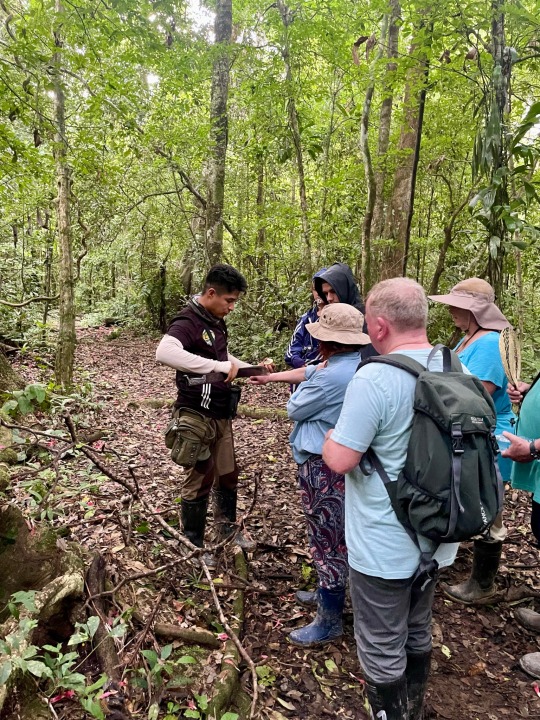
At various points most of the group have been dressed down by Marco for talking too much or asking a question if it’s already been answered. He’s very friendly but at the same time he won’t hold back if he gets frustrated 😂
We also learn a bit more about the timber trade - we see another beautiful Ceiba Pentandra tree which is about 50 meters high and is the tree where the king vultures were perched that we spotted from the tower yesterday. The base of the trees trunk reminds me of a fig. Unfortunately these trees are logged for making plywood. Marco explains that the Chunchos land under its original owner was used to log mahogany and cedar to the point that these trees cannot be found here anymore. Plus planting of rubber trees and harvesting of latex for the car industry.
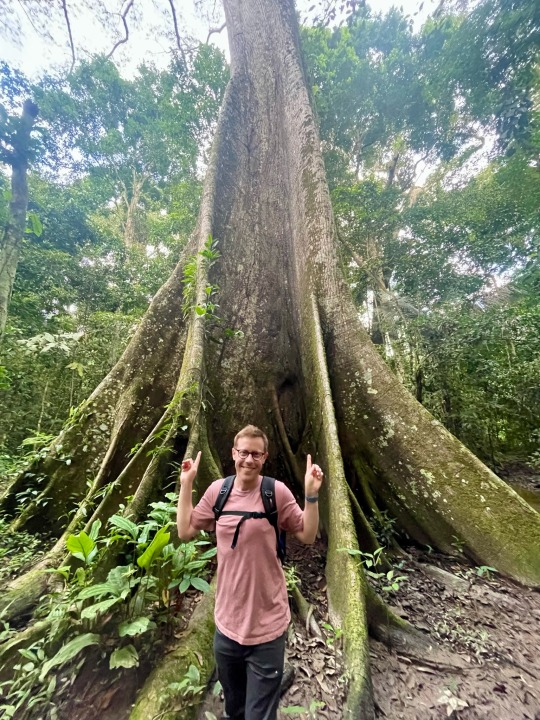
We also stop at an Ironwood (Shihuahuaco) tree. This hardwood is good for building houses hence why it is a target for loggers. Shockingly it is also commonly used for charcoal packets in Europe - what a waste!! Apparently the government will protect this tree within 18months. The Brazil Nut also a target for its timber has already been protected.
These trees are near the property’s boundary and if they were outside they would have already been cut down for sure.
We head back to the hotel via the shortcut route which I am glad about as I’ve been struggling on this walk.
When we get back Marco offers to take us back out in another hour for a night walk and I’d love to go but we decide to stay home as I’m feeling so exhausted.
For dinner we have spag bol and end up staying talking to our group until nearly 10pm. By the time I get up from the table and walk back to the room I suddenly realise how ill I feel - I am completely wiped out, my body is aching. It’s time for bed but I cannot sleep as I am coughing so much and my fever is back throughout night.
1 note
·
View note
Text
Museu do Jardim Botânico destaca papel da ciência ante crise ecológica
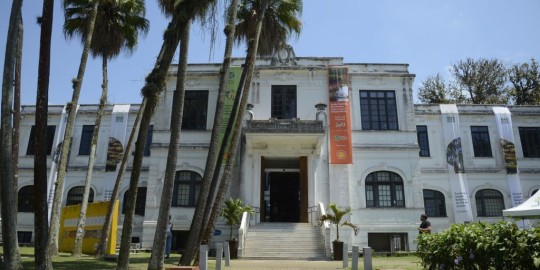
O Jardim Botânico do Rio de Janeiro (JBRJ) abre nesta sexta-feira (8), às 10h, um novo espaço cultural, com entrada gratuita para o público e classificação livre. Trata-se do Museu do Jardim Botânico, que funcionará no casarão do início do século 20, com entrada pela Rua Jardim Botânico, 1008, no bairro do mesmo nome, e que recebeu investimento de R$ 12 milhões da Shell para revitalização. O Instituto de Desenvolvimento e Gestão (IDG) será responsável pela gestão do museu, que funcionará de quinta a terça-feira, das 10h às 17h, com a última entrada às 16h. Os ingressos podem ser retirados pelo site Botanical Garden RJ - Tickets. O museu conta com 14 salas no total, sendo 12 expositivas. O presidente do Jardim Botânico, Sérgio Besserman, disse nesta terça-feira (5) à Agência Brasil que o novo museu mostra a ciência que a instituição faz, “a importância da ciência feita no JB para conservação e restauração da natureza do Brasil, das florestas principalmente, de todos os biomas; e também um pouco da história do Jardim”. Fundado em 13 de junho de 1808, o JB surgiu de decisão do então príncipe regente português, D. João de Bragança, de instalar no local uma fábrica de pólvora e um jardim para aclimatação de espécies vegetais originárias de outras partes do mundo. Atualmente é o Instituto de Pesquisas Jardim Botânico do Rio de Janeiro, órgão federal vinculado ao Ministério do Meio Ambiente e considerado um dos mais importantes centros de pesquisa mundiais nas áreas de botânica e conservação da biodiversidade. Relevância Besserman informou que não se mostrará somente o ferramental tecnológico, mas também a relevância da ciência para enfrentar a crise ecológica e apoiar o combate à crise de biodiversidade no Brasil. “Há uma participação muito intensa dos cientistas do JB. Cada peça das exposições permanentes de cada sala, tudo foi feito com participação muito direta e intensa dos próprios cientistas do equipamento, junto com a museologia do IDG”. Segundo Besseraman, o novo museu reforça o lema do Jardim Botânico: “Muito mais que um jardim: ciência, ensino e história”. As políticas públicas e ações assertivas desenvolvidas pelo JB para conhecimento e conservação da flora brasileira ao longo de mais de 200 anos de história serão compartilhadas com o público, revelando detalhes das expedições de campo, do trabalho dos botânicos, da pesquisa científica aplicada à conservação da biodiversidade e as atividades dos laboratórios. “Há salas mostrando pesquisas avançadas de biologia molecular para identificar origem e até localização de madeira, o que ajuda a combater o desmatamento ilegal”, acrescentou Besserman. Além das exposições permanentes, o museu terá conteúdos interativos e ampla programação educativa e cultural. Logo na entrada do museu, os visitantes conhecerão uma exposição de longa duração, concebida em colaboração com um comitê de funcionários e pesquisadores do Jardim Botânico, que traz a essência do novo equipamento cultural e científico por meio de mais de dez experiências. Um dos destaques é a obra Sumaúma: Copa, Casa, Cosmos, filme de Estevão Ciavatta, com narração de Regina Casé, que promove uma imersão virtual na sumaúma (Ceiba pentandra), árvore amazônica presente na coleção viva do instituto e carregada de simbolismos. Para muitos povos, a sumaúma é o lar de entidades divinas ou mesmo um portal que leva a diferentes mundos. Obra Sumaúma: Copa, Casa, Cosmos, no Museu do Jardim Botânico - Tomaz Silva/Agência Brasil Indígenas O espaço apresenta instalações do artista e ativista dos direitos indígenas Denilson Baniwa, além da exposição temporária Mbae Kaá, o que tem na mata: Barbosa Rodrigues entre plantas e pajés. O trabalho é do ex-presidente do JBRJ João Barbosa Rodrigues e mostra que, enquanto a ciência ocidental dá nome às plantas pelo sistema do naturalista sueco Charles Linneo, os indígenas tupis-guaranis as denominavam por alguma característica apresentada, como planta com mancha amarela, planta com espinho grande, por exemplo. “É sempre alguma coisa relativa à planta. Essa exposição ficará por alguns meses no museu e depois será substituída por outra, também temporária”, informou Besserman. Segundo ele, as exposições permanentes serão atualizadas e modificadas, mas ficarão sempre abertas ao público. Fazem parte ainda do museu uma sala de leitura, com diversos livros e versões digitais de obras raras do acervo da Biblioteca Barbosa Rodrigues do Jardim Botânico, que poderão ser folheados em telas táteis; uma sala multiuso para encontros, palestras e eventos e uma ampla programação educativa e cultural. Na avaliação de Besserman, o novo equipamento é uma iniciativa boa para o Rio de Janeiro, “para valorizar a ciência em geral, assim como o conhecimento dos povos tradicionais, e um novo espaço cultural importante para o país”. Patrocínio Há mais de 110 anos no país, a Shell é uma empresa de energia integrada com participação em upstream (exploração e produção de petróleo), no novo mercado de gás natural, pesquisa e desenvolvimento e energias renováveis, entre outras áreas. A empresa é a patrocinadora master do Museu do Jardim Botânico. O Instituto de Desenvolvimento e Gestão é uma organização sem fins lucrativos especializada na gestão de centros culturais públicos e programas ambientais, que também presta consultoria para empresas privadas e atua na execução, desenvolvimento e implementação de projetos culturais e ambientais. Atualmente o IDG é responsável pela gestão dos museus do Amanhã e do Jardim Botânico, no Rio de Janeiro; do Paço do Frevo, no Recife; do Museu das Favelas, em São Paulo; e é gestor operacional do Fundo da Mata Atlântica, além de realizador das ações de conservação e consolidação do sítio arqueológico do Cais do Valongo, na região portuária do Rio. Também foi responsável pela implementação da museografia do Memorial às Vítimas do Holocausto, no Rio. Fonte: EBC GERAL Read the full article
0 notes
Text
What is Kapok Fiber? Properties & Application
What is Kapok Fiber? Kapok Fiber is known as silk cotton. It is a natural fiber derived from the seed pods of the kapok tree (Ceiba pentandra). The Kapok tree is native to the tropical regions of the Americas, Africa, and Asia. With a rich history dating back centuries, kapok fiber has garnered attention for its unique properties and versatile applications. Natural cellulosic fiber. Obtained…
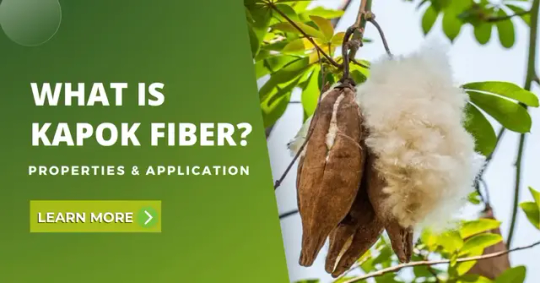
View On WordPress
0 notes
Link
Sumaúma, la 'Ceiba pentandra' es un gigantesco árbol reverenciado por tribus de la Amazonía brasileña que lo ven como la conexión entre el cielo y la tierra
0 notes
